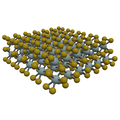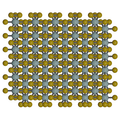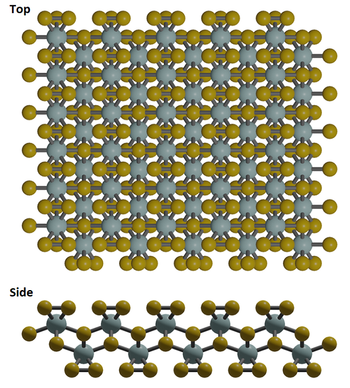Zirconium Triselenide (ZrSe3) Powders and Crystals
CAS Number 12166-53-9
2D Materials, Low Dimensional Materials, Materials, Transition Metal Chalcogenides (TMCs)Low price, high purity 2D zirconium triselenide powder and crystals
For the development of next-generation electronics, optoelectronics, and nanotechnology
Technical Data | MSDS | Literature and Reviews | Related Products
Zirconium triselenide (ZrSe3, CAS number 12166-53-9) belongs to the IVB layered transition metal trichalcogenides (TMTCs).
ZrSe3 has a chain-like structure and crystallises in the monoclinic space group P21/m. Each zirconium atom at the centre is coordinated to six parallel arranged selenide atoms forming distorted trigonal prisms.
ZrSe3 is a n-type characteristic semiconductor with an indirect bandgap of 1.1 eV and a direct bandgap of 1.47 eV. The indirect bandgap of ZrSe3 monolayers increases with the tensile strain, but the indirect character is retained in most cases.
High Purity
>99.999% Zirconium Triselenide Crystal Purity
Powder & Crystal
Different Forms of Zirconium Triselenide
Low Cost
Low Cost Zirconium Triselenide
Semiconductor
N-type semiconductor
We supply zirconium triselenide in both powdered and crystal forms.

Zirconium Triselenide Powder
Can be used for preparation of zirconium triselenide nanoplates and ultrathin films
Available in quantities of 1 g
≥99.995% purity
From £350

Zirconium Triselenide Crystals by Size
Can be used to produce single or few-layer zirconium triselenide sheets via mechanical or liquid exfoliation
Small (≥10 mm2) or medium (≥25 mm2) crystals available*
≥99.999% purity
From £520
Bulk single zirconium triselenide crystal is most commonly used as sources from which single or few-layer sheets can be obtained via either mechanical or liquid exfoliation. Single zirconium triselenide crystal or films produced from such crystals are suitable for study using atomic force microscopy or transmission electron microscopy
Few-layer ZrSe3 nanosheets and nanoparticles can also obtained from zirconium triselenide powder by liquid-exfoliation.
Technical Data
| CAS Number | 12166-53-9 |
| Chemical Formula | ZrSe3 |
| Molecular Weight | 328.10 g/mol |
| Bandgap | 1.10 eV (indirect) [1] |
| Preparation | Synthetic - Chemical Vapour Transport (CVT) |
| Structure | Monoclinic P |
| Electronic Properties | 2D semiconductor |
| Melting Point | N/A |
| Colour | Black |
| Synonyms | Zirconium triselenide, Zirconium selenides |
| Classification / Family | Transition metal trichalcogenides (TMTCs), 2D Semiconductor materials, Nano-electronics, Nano-photonics, Photovoltaic, Materials science |
Product Details
| Form | Purity |
| Powder | ≥99.995% |
| Crystal | ≥99.999% |
Pricing Table
| Product Code | Form | Size/Weight* | Price |
| M2204C1 | Powder | 1 g | £350 |
| M2204A10 | Crystal | Small (≥10 mm2) | £520 ea. |
| M2204A25 | Crystal | Medium (≥25 mm2) | £850 ea. |
*typical representative size, areas/dimensions may vary
Shipping is free for qualifying orders placed via our secure online checkout.
MSDS Documents
Structure of Zirconium Triselenide
Like the crystal structure of ZrS3, ZrSe3 has a chain-like structure belonging to the space group P21/m. Each zirconium atom at the centre is coordinated to six parallel arranged selenide atoms forming distorted trigonal prisms.
Better described by ionic model as Zr4+(Se2)2-Se2-, there are two types of Se atoms in the crystal system. Shown in the crystal structure below, a basic structural fragment prism {ZrSe6/2} is constructed from two diselenide (Se‒Se)2- groups as well as two selenide groups Se2- with Zr atom situated near the centre of the prism. Such prisms with metal atoms situated close to the prism centres are connected to each other via common triangle bases to form infinite columns. This leads to strong anisotropic behaviour that offers additional advantages over isotropic 2D systems.

Literature and Reviews
- Slot-die printed two-dimensional ZrS3 charge transport layer for perovskite light-emitting diodes. Dmitry S. Muratov et al. ACS Applied Materials & Interfaces (2019). Just accepted manuscript: https://doi.org/10.1021/acsami.9b16457
- Single layer of MX3 (M=Ti, Zr; X=S, Se, Te): a new platform for nano-electronics and optics, Y. Jin et al., Phys. Chem. Chem. Phys., 17, 18665-18669 (2015); DOI: 10.1039/C5CP02813B.
- Optical and electrical properties of ZrSe3 single crystals grown by chemical vapour transport technique, K. Patel et al., Bull. Mater. Sci., 28(5), 405–410 (2005); doi: 10.1007/BF02711227.
Related Products
We stock a wide range of 2D materials available to purchase online. Please contact us if you cannot find what you are looking for.

 Zirconium triselenide powder
Zirconium triselenide powder

